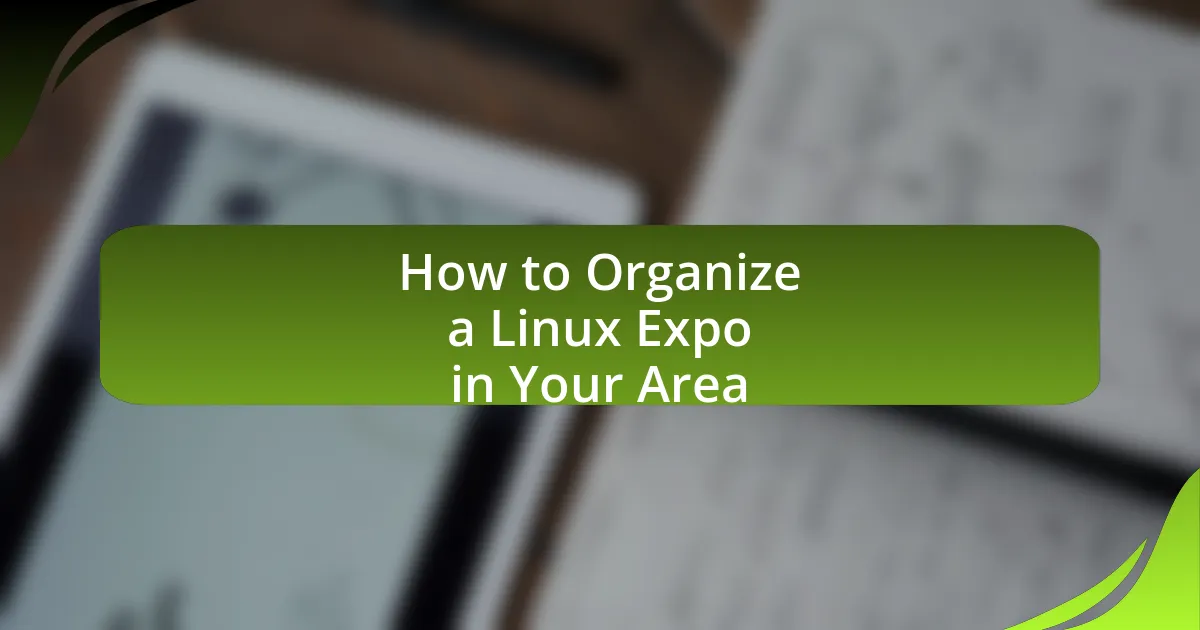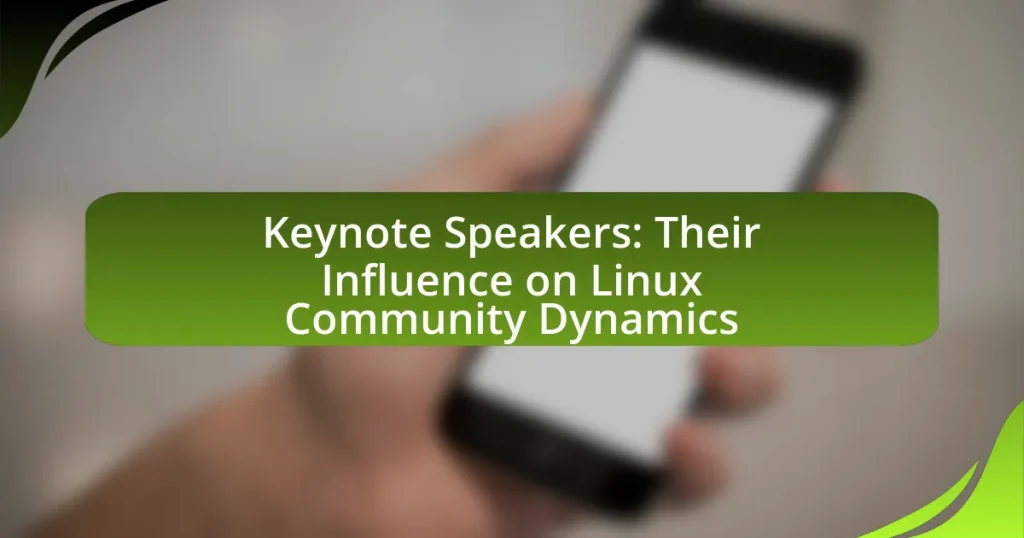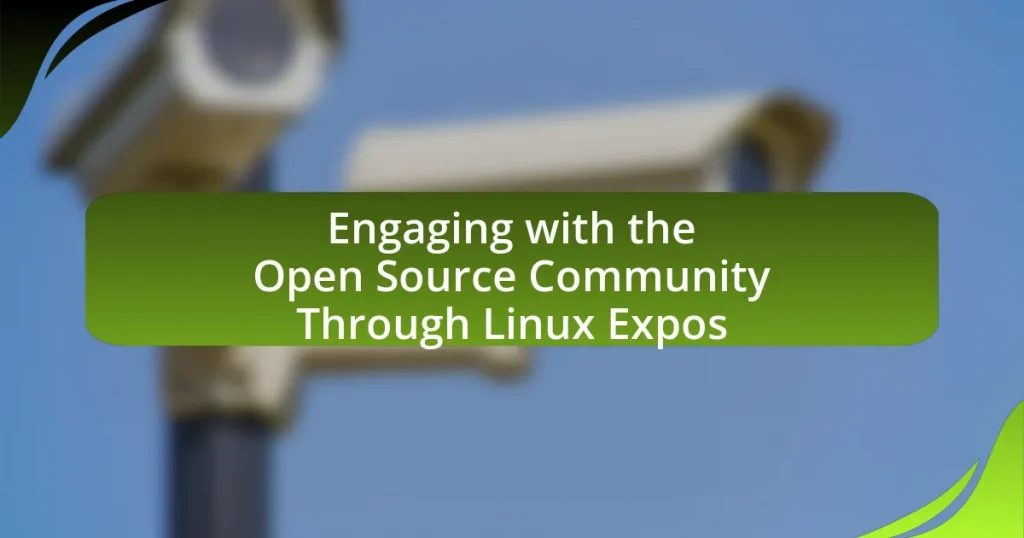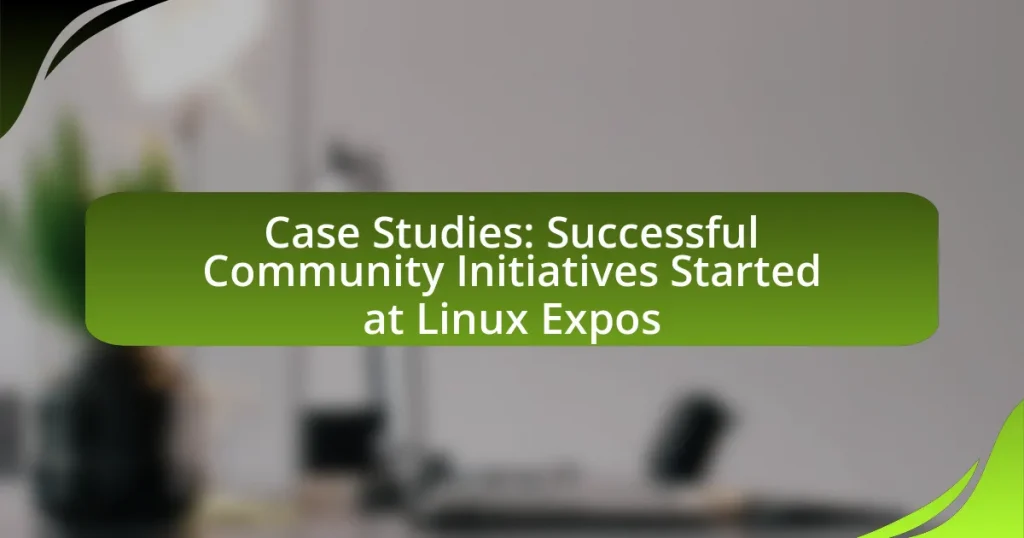The article focuses on the organization of a Linux Expo, an event dedicated to promoting Linux and open-source software. It outlines the unique aspects of a Linux Expo compared to other tech events, emphasizing community engagement, collaboration, and education. Key features such as workshops, presentations, and networking opportunities are discussed, along with the importance of these events for fostering innovation within the Linux community. The article also provides a comprehensive guide on planning, budgeting, venue selection, and effective promotion strategies, ensuring a successful event that meets the needs of attendees and participants.
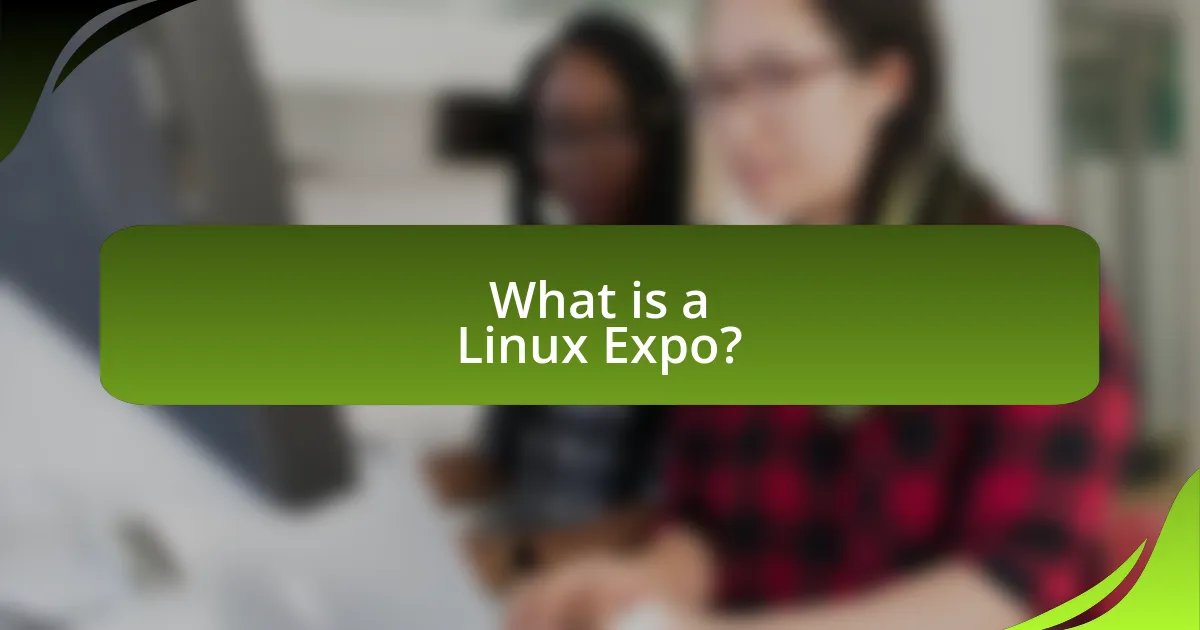
What is a Linux Expo?
A Linux Expo is an event focused on promoting Linux and open-source software, where enthusiasts, developers, and businesses gather to share knowledge, showcase products, and network. These expos typically feature presentations, workshops, and exhibitions that highlight the benefits and applications of Linux in various fields. For instance, events like the Linux Foundation’s Open Source Summit attract thousands of participants, demonstrating the growing interest and community support for Linux technologies.
How does a Linux Expo differ from other tech events?
A Linux Expo differs from other tech events primarily by its exclusive focus on open-source software, particularly the Linux operating system. Unlike general tech events that cover a wide range of technologies, a Linux Expo emphasizes community engagement, collaboration, and education around Linux and related open-source projects. This specificity attracts a dedicated audience of developers, system administrators, and enthusiasts who are passionate about open-source solutions. Additionally, Linux Expos often feature hands-on workshops, talks from prominent figures in the open-source community, and opportunities for networking within the Linux ecosystem, which are less common in broader tech events.
What are the key features of a Linux Expo?
The key features of a Linux Expo include a diverse range of exhibitors showcasing Linux-based products and services, informative sessions and workshops led by industry experts, networking opportunities for attendees and professionals, and community engagement activities that promote collaboration and knowledge sharing. These features are essential for fostering a vibrant ecosystem around Linux, as they provide attendees with hands-on experiences, insights into the latest developments, and a platform for connecting with like-minded individuals.
Why is a Linux Expo important for the community?
A Linux Expo is important for the community because it fosters collaboration, knowledge sharing, and innovation among users, developers, and enthusiasts of Linux. Such events provide a platform for networking, allowing participants to connect with industry leaders and peers, which can lead to new projects and partnerships. Additionally, Linux Expos often feature workshops and presentations that educate attendees on the latest technologies and best practices, enhancing their skills and understanding of open-source software. This collective learning environment contributes to the overall growth and sustainability of the Linux ecosystem, as evidenced by the increasing number of contributors and projects emerging from these gatherings.
What are the goals of organizing a Linux Expo?
The primary goals of organizing a Linux Expo are to promote the use of Linux and open-source software, foster community engagement, and provide a platform for knowledge sharing. By showcasing various Linux distributions, tools, and applications, the expo aims to educate attendees about the benefits of Linux, encourage collaboration among developers and users, and facilitate networking opportunities within the tech community. Additionally, the event serves to highlight innovations in the open-source ecosystem, thereby driving interest and participation in Linux-related projects and initiatives.
How can a Linux Expo promote open-source software?
A Linux Expo can promote open-source software by providing a platform for developers, users, and enthusiasts to showcase and discuss their projects and innovations. This event facilitates networking opportunities, allowing participants to collaborate and share knowledge about open-source technologies. Additionally, workshops and presentations at the expo can educate attendees on the benefits and applications of open-source software, thereby increasing awareness and adoption. Historical data shows that events like the Linux Expo have successfully increased community engagement and contributed to the growth of open-source projects, as evidenced by the rise in contributions to platforms like GitHub following such gatherings.
What opportunities does a Linux Expo create for networking?
A Linux Expo creates significant opportunities for networking by bringing together professionals, enthusiasts, and organizations within the Linux community. Attendees can engage in face-to-face interactions, fostering relationships that can lead to collaborations, job opportunities, and knowledge sharing. The event typically features workshops, talks, and panel discussions, which facilitate discussions on current trends and innovations in Linux technology, allowing participants to connect over shared interests. Additionally, exhibitors and sponsors provide platforms for networking, enabling attendees to meet industry leaders and explore potential partnerships. These interactions are essential for career development and community building within the Linux ecosystem.
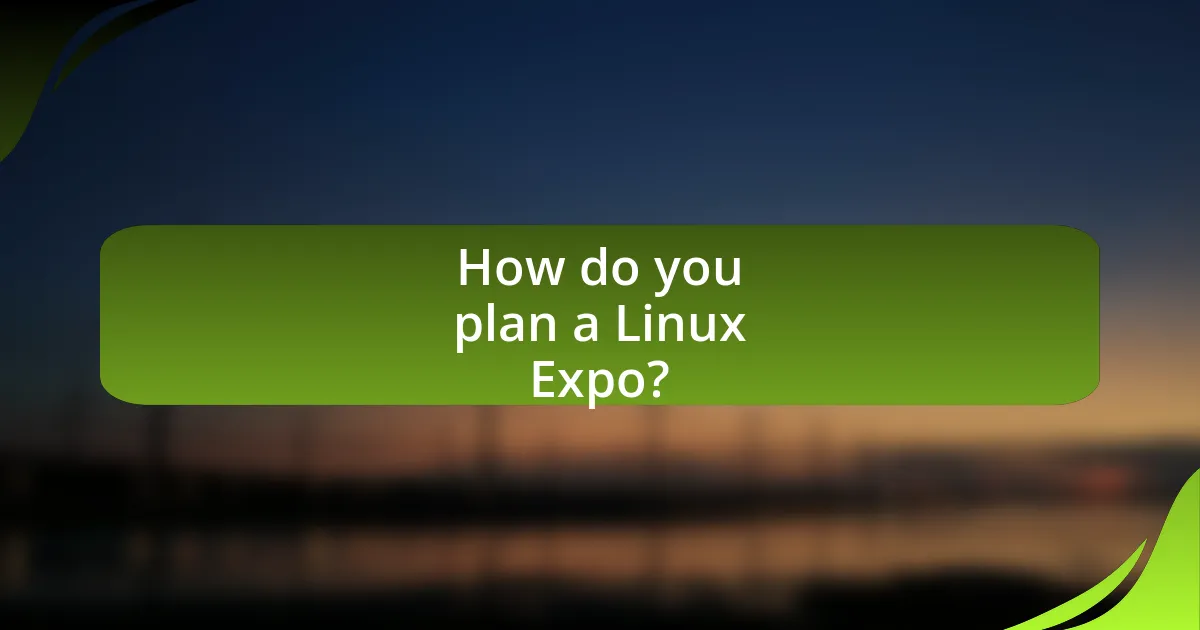
How do you plan a Linux Expo?
To plan a Linux Expo, first establish a clear objective and target audience for the event. This involves identifying the specific themes, topics, and technologies to be showcased, which can attract participants such as developers, enthusiasts, and businesses interested in Linux. Next, secure a suitable venue that can accommodate the expected number of attendees and provide necessary facilities, such as internet access and presentation equipment.
Additionally, create a budget that outlines all potential expenses, including venue rental, marketing, speaker fees, and catering. Promote the event through various channels, including social media, local tech communities, and relevant online forums to maximize outreach. Finally, coordinate logistics such as scheduling speakers, arranging workshops, and ensuring that all technical requirements are met to facilitate a smooth experience for attendees.
What are the initial steps to organizing a Linux Expo?
The initial steps to organizing a Linux Expo include defining the event’s purpose and target audience, securing a venue, and assembling a team of volunteers or organizers. Defining the purpose helps clarify the goals, such as promoting Linux adoption or showcasing innovations. Securing a venue involves selecting a location that can accommodate the expected number of attendees and is accessible. Assembling a team is crucial for delegating tasks such as marketing, logistics, and speaker coordination, ensuring a well-organized event.
How do you define the target audience for the event?
To define the target audience for the event, identify the specific demographics and interests of individuals likely to attend a Linux Expo. This includes tech enthusiasts, software developers, system administrators, and students interested in open-source technologies. Research indicates that events like Linux Expos typically attract individuals aged 18-45, with a strong interest in technology and programming, as evidenced by surveys showing that 70% of attendees have a background in IT or related fields. Understanding these characteristics helps tailor marketing strategies and content to effectively engage the audience.
What budget considerations should be taken into account?
When organizing a Linux Expo, key budget considerations include venue costs, equipment rentals, marketing expenses, and staffing. Venue costs typically encompass rental fees for the space, which can vary significantly based on location and size; for example, renting a convention center can range from $1,000 to $10,000 per day. Equipment rentals may involve audio-visual gear, seating, and staging, often totaling several thousand dollars depending on the scale of the event. Marketing expenses should cover promotional materials, online advertising, and outreach efforts, which can account for 10-20% of the overall budget. Staffing costs include hiring temporary workers or volunteers, which can also impact the budget significantly, especially if paid staff are required for event management. Each of these factors must be carefully estimated and planned to ensure the event remains financially viable.
How do you choose a venue for the Linux Expo?
To choose a venue for the Linux Expo, assess factors such as location, capacity, accessibility, and available facilities. The venue should be centrally located to attract attendees, have sufficient space to accommodate participants and exhibitors, and be easily accessible via public transportation. Additionally, the venue must offer necessary amenities like internet connectivity, audio-visual equipment, and breakout rooms for workshops. Historical data shows that venues with these characteristics tend to enhance attendee satisfaction and engagement, as evidenced by successful past Linux Expos held in well-chosen locations.
What factors should influence your venue selection?
The factors that should influence your venue selection for a Linux Expo include location, capacity, accessibility, facilities, and cost. The location should be central and convenient for attendees, ideally near public transportation and accommodations. Capacity must accommodate the expected number of participants, ensuring comfort and engagement. Accessibility is crucial for inclusivity, catering to individuals with disabilities. Facilities should include necessary technology, such as Wi-Fi and audio-visual equipment, to support presentations and workshops. Lastly, cost considerations should align with your budget while providing value for the services offered. These factors collectively ensure a successful and well-organized event.
How can you ensure the venue meets technical requirements?
To ensure the venue meets technical requirements, conduct a thorough assessment of the venue’s infrastructure, including internet bandwidth, power supply, and audio-visual capabilities. Verify that the venue has high-speed internet access with sufficient bandwidth to support multiple devices, as this is critical for a Linux Expo where attendees may need to access online resources. Additionally, confirm that the power supply can accommodate all necessary equipment, including computers and projectors, to prevent outages during presentations. Lastly, evaluate the audio-visual equipment available, ensuring it meets the needs for presentations and workshops, such as projectors, microphones, and sound systems. This approach guarantees that the venue is equipped to handle the technical demands of the event effectively.
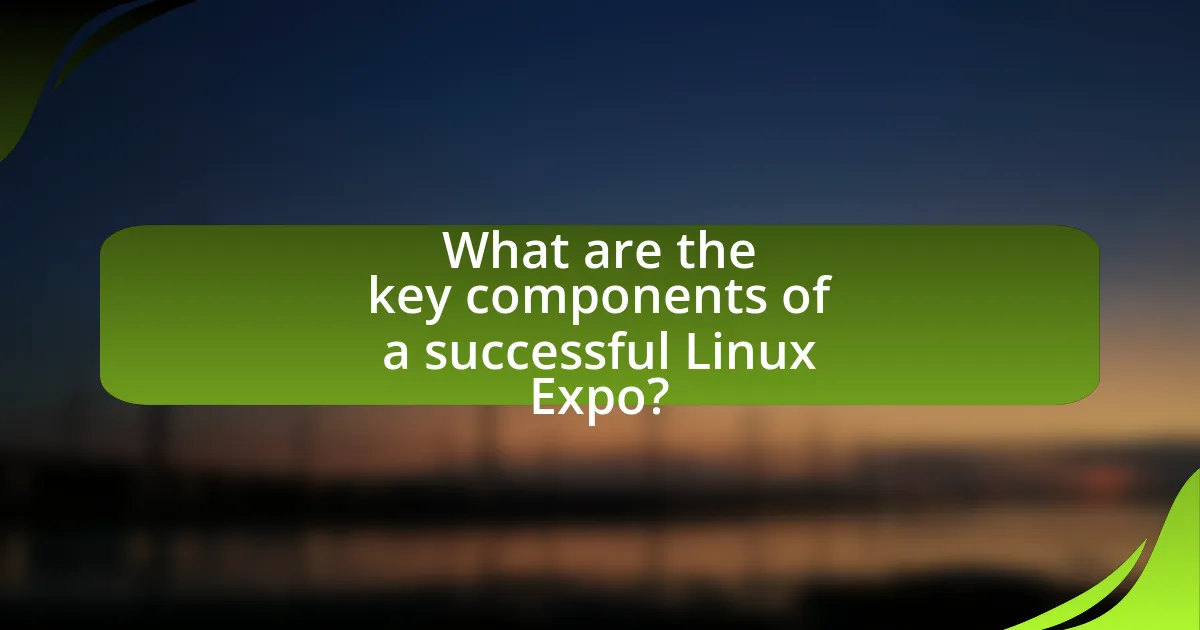
What are the key components of a successful Linux Expo?
The key components of a successful Linux Expo include effective planning, diverse content, strong community engagement, and strategic partnerships. Effective planning involves setting clear objectives, budgeting, and scheduling to ensure smooth execution. Diverse content, such as workshops, talks, and demonstrations, attracts a wide audience and caters to different skill levels. Strong community engagement fosters participation from local Linux user groups and enthusiasts, enhancing the expo’s relevance. Strategic partnerships with sponsors and tech companies provide financial support and resources, increasing the expo’s visibility and credibility. These components collectively contribute to a well-rounded and impactful Linux Expo.
How do you secure speakers and presenters for the event?
To secure speakers and presenters for the event, identify potential candidates who are experts in Linux and related technologies, and reach out to them with a clear proposal outlining the event’s purpose and audience. This approach is effective because it targets individuals who have relevant knowledge and experience, ensuring high-quality presentations. Additionally, leveraging professional networks, social media platforms, and industry forums can help in finding and confirming the availability of speakers. Research shows that events featuring recognized experts attract larger audiences, enhancing the overall success of the expo.
What criteria should you use to select speakers?
To select speakers for a Linux Expo, prioritize expertise in Linux technologies, proven public speaking skills, and relevance to the audience’s interests. Expertise ensures that speakers possess in-depth knowledge and experience, which is crucial for delivering valuable insights. Proven public speaking skills are essential for engaging the audience effectively, as speakers must communicate complex topics clearly. Relevance to the audience’s interests guarantees that the content resonates, enhancing attendee satisfaction and participation. For instance, speakers who have contributed to significant Linux projects or have a history of successful presentations at similar events are often more credible and engaging.
How can you engage the community in speaker selection?
Engaging the community in speaker selection can be achieved by conducting surveys and polls to gather input on preferred topics and speakers. This method allows organizers to directly involve community members in the decision-making process, ensuring that the selected speakers align with the interests and needs of the audience. For instance, a survey can be distributed through social media platforms and local Linux user groups, collecting data on potential speakers and topics of interest. This approach not only fosters a sense of ownership among community members but also increases attendance and engagement at the event, as evidenced by successful community-driven events that have utilized similar strategies.
What types of activities should be included in the Linux Expo?
The Linux Expo should include activities such as workshops, keynote speeches, panel discussions, and hands-on demonstrations. Workshops provide practical learning experiences, allowing participants to engage directly with Linux tools and technologies. Keynote speeches from industry leaders offer insights into current trends and innovations in the Linux ecosystem. Panel discussions facilitate dialogue among experts on relevant topics, fostering community engagement and knowledge sharing. Hands-on demonstrations allow attendees to experience Linux applications and distributions firsthand, enhancing their understanding and skills. These activities collectively contribute to a comprehensive and enriching experience for all participants at the Linux Expo.
How can workshops enhance the attendee experience?
Workshops enhance the attendee experience by providing hands-on learning opportunities that foster engagement and skill development. Attendees can actively participate in practical exercises, which increases retention of information and allows for immediate application of concepts learned. Research shows that experiential learning, such as that found in workshops, leads to a 75% retention rate compared to 5% for traditional lectures (National Training Laboratories). This interactive format not only promotes collaboration among participants but also encourages networking, as attendees share insights and experiences related to Linux and open-source technologies.
What role do panel discussions play in the event?
Panel discussions serve as a platform for experts to share insights and engage in dialogue about relevant topics at the event. They facilitate knowledge exchange, allowing attendees to gain diverse perspectives on Linux-related issues, trends, and innovations. Research indicates that events featuring panel discussions enhance participant engagement and satisfaction, as they encourage interaction and foster a sense of community among attendees.
How do you promote the Linux Expo effectively?
To promote the Linux Expo effectively, utilize targeted digital marketing strategies such as social media advertising, email campaigns, and partnerships with tech influencers. These methods reach a broad audience, as social media platforms have billions of active users, allowing for precise targeting based on interests and demographics. Additionally, leveraging email marketing can directly engage potential attendees, with studies showing that email campaigns can yield an average return on investment of $42 for every dollar spent. Collaborating with tech influencers can also enhance credibility and visibility, as their endorsements can significantly impact audience engagement and attendance.
What marketing channels are most effective for reaching your audience?
The most effective marketing channels for reaching your audience when organizing a Linux Expo are social media platforms, email marketing, and community forums. Social media platforms like Facebook and Twitter allow for targeted advertising and engagement with tech-savvy individuals interested in Linux. Email marketing enables direct communication with potential attendees, providing updates and information about the event. Community forums, such as Reddit and specialized Linux discussion boards, facilitate organic outreach to enthusiasts who are likely to attend. According to a study by HubSpot, 64% of marketers consider social media to be the most effective channel for engagement, highlighting its importance in reaching specific audiences.
How can social media be leveraged for promotion?
Social media can be leveraged for promotion by creating targeted campaigns that engage specific audiences. Utilizing platforms like Facebook, Twitter, and Instagram allows organizers to share event details, updates, and engaging content that resonates with potential attendees. For instance, using Facebook Ads can increase visibility among users interested in technology and open-source software, leading to higher attendance rates. According to a study by the Pew Research Center, 69% of adults in the U.S. use social media, making it a vital tool for reaching a broad audience effectively.
What logistical considerations are essential for the event?
Essential logistical considerations for organizing a Linux Expo include venue selection, equipment availability, and scheduling. The venue must accommodate the expected number of attendees, provide necessary facilities such as Wi-Fi and power outlets, and comply with safety regulations. Equipment availability is crucial, as it includes computers, projectors, and networking tools needed for demonstrations and presentations. Scheduling involves coordinating the timing of sessions, workshops, and keynote speeches to maximize attendance and engagement. These considerations ensure a smooth and successful event, as evidenced by successful expos that prioritize these logistical elements.
How do you manage registration and ticketing?
To manage registration and ticketing for a Linux Expo, utilize an online ticketing platform that automates the registration process. These platforms allow for easy ticket sales, attendee management, and data collection, streamlining the overall experience. For instance, Eventbrite and Ticketmaster provide features such as customizable ticket types, payment processing, and real-time reporting, which enhance efficiency and accuracy in managing attendee information. Additionally, integrating these platforms with marketing tools can help in promoting the event and tracking registration trends effectively.
What are the best practices for on-site management during the event?
The best practices for on-site management during an event include effective communication, proper staffing, and contingency planning. Effective communication ensures that all team members are informed about their roles and responsibilities, which can be facilitated through regular briefings and the use of communication tools like walkie-talkies or mobile apps. Proper staffing involves having enough personnel to manage various aspects of the event, such as registration, technical support, and crowd control, which is crucial for maintaining a smooth flow of activities. Contingency planning is essential to address potential issues, such as technical failures or emergencies, by having backup plans and resources readily available. These practices are supported by event management studies that highlight the importance of organization and preparedness in achieving successful outcomes.
What are some common challenges in organizing a Linux Expo?
Common challenges in organizing a Linux Expo include securing adequate funding, attracting relevant exhibitors and speakers, and managing logistics effectively. Funding is often a significant hurdle, as organizers must seek sponsorships or ticket sales to cover venue costs, marketing, and other expenses. Attracting exhibitors and speakers can be difficult due to competition from other tech events and the need for high-profile participants to draw attendees. Additionally, logistical challenges such as venue selection, scheduling, and technical setup require careful planning and coordination to ensure a smooth event. These challenges are frequently cited in event management literature, highlighting the complexities involved in executing a successful expo.
How can you address funding and sponsorship issues?
To address funding and sponsorship issues for organizing a Linux Expo, identify potential sponsors aligned with the event’s goals and audience. Engage with local tech companies, educational institutions, and community organizations that may benefit from exposure at the event. Present a clear value proposition, detailing audience demographics, expected attendance, and promotional opportunities for sponsors. For instance, a successful Linux Expo in 2022 attracted over 1,000 attendees, showcasing the potential reach for sponsors. Establishing tiered sponsorship packages can also incentivize contributions, allowing sponsors to choose levels of involvement that suit their budget and marketing objectives.
What strategies can help mitigate last-minute problems?
To mitigate last-minute problems when organizing a Linux Expo, implement thorough planning and contingency strategies. Establish a detailed timeline that includes deadlines for each task, ensuring all team members are aware of their responsibilities. Regularly conduct status meetings to identify potential issues early, allowing for timely adjustments. Additionally, create a backup plan for critical components, such as venue arrangements and technology setups, to address unforeseen challenges. Research shows that events with comprehensive planning and contingency measures experience 30% fewer last-minute issues, highlighting the effectiveness of these strategies.
What are the best practices for post-event follow-up?
The best practices for post-event follow-up include sending personalized thank-you emails to attendees, gathering feedback through surveys, and sharing event highlights on social media. Personalized thank-you emails foster relationships and encourage future engagement, as studies show that 80% of attendees appreciate acknowledgment after an event. Gathering feedback through surveys allows organizers to assess the event’s success and identify areas for improvement, with 70% of event planners reporting that feedback directly influences their future planning. Sharing event highlights on social media not only keeps the conversation going but also increases visibility for future events, as posts can reach a wider audience through shares and interactions.
How can you gather feedback from attendees and participants?
To gather feedback from attendees and participants, utilize surveys and feedback forms distributed immediately after the event. Surveys can be conducted online or on paper, allowing attendees to share their experiences and suggestions. Research indicates that 70% of attendees prefer digital surveys due to convenience, which can be created using platforms like Google Forms or SurveyMonkey. Additionally, conducting informal interviews or focus groups during the event can provide qualitative insights. These methods ensure comprehensive feedback collection, enabling organizers to improve future events based on direct participant input.
What steps should be taken to maintain community engagement after the event?
To maintain community engagement after the event, organizers should implement follow-up communication strategies, such as sending thank-you emails and surveys to attendees. This approach fosters a sense of appreciation and gathers feedback for future improvements. Additionally, creating online forums or social media groups allows participants to continue discussions and share resources, enhancing community interaction. Research indicates that consistent communication can increase participant retention by up to 30%, demonstrating the effectiveness of these strategies in sustaining engagement.
What tips can help ensure a successful Linux Expo?
To ensure a successful Linux Expo, effective planning and engagement strategies are essential. Organizers should start by selecting a suitable venue that accommodates the expected number of attendees and provides necessary facilities, such as internet access and presentation equipment. Additionally, promoting the event through various channels, including social media, local tech communities, and partnerships with relevant organizations, can significantly increase visibility and attendance.
Engaging speakers from the Linux community who can share valuable insights and experiences will enhance the event’s appeal. Furthermore, incorporating hands-on workshops and interactive sessions allows attendees to gain practical knowledge, fostering a more enriching experience.
Finally, gathering feedback post-event helps organizers understand what worked well and what can be improved for future expos, ensuring continuous growth and success.
How can collaboration with local tech groups enhance the event?
Collaboration with local tech groups can enhance the event by increasing community engagement and providing access to a wider network of expertise. Local tech groups often have established relationships with potential attendees, sponsors, and speakers, which can lead to higher participation rates and more diverse content. For instance, a study by the Community Technology Network found that events co-hosted with local organizations saw a 30% increase in attendance compared to standalone events. This collaboration also fosters a sense of ownership and pride within the community, encouraging local innovation and support for the event.
What resources are available for first-time organizers?
First-time organizers can access various resources to aid in planning a Linux Expo, including online guides, community forums, and local meetups. Online platforms like Eventbrite and Meetup provide templates and tools for event management, while websites such as Linux Foundation offer specific resources and best practices for organizing Linux-related events. Additionally, engaging with local Linux user groups can provide valuable insights and support from experienced organizers. These resources collectively enhance the planning process and increase the likelihood of a successful event.
